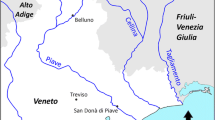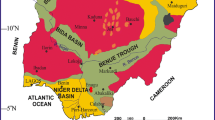Summary
The Vaiont Slope Failure
The paper discusses the Vaiont Slope Failure as an example of sequential failure involving a third order failure mechanism. Laboratory evidence obtained with sand models is presented in support of the argument and from this arises the concept of dilatant zones which allow formerly tightly packed rock zones to dilate and permit block rotation and shearing to contribute to a considerable reduction in strength. Field measurements of movement vectors originally made by Müller also provide evidence in support of the mechanism. Using the author's clastic analysis, together with possible pore pressure changes on the initiating failure surface, it is shown that on backanalysis values of tanφ′ required according to Müller in the range 0.7 to 0.8, can be obtained. An important phenomenon observed in the Vaiont slide was the rate at which the material moved into the valley. It is suggested that the energy liberated by the strain-softening characteristics of the material involved played a major role, but it is also considered that, once initiated, pore water pressure increase on the failure surface analogous to the phenomenon of aquaplaning in vehicle skidding on wet pavements may also have contributed to the rate of movement.
Zusammenfassung
Die Rutschung von Vajont
In diesem Beitrag wird die Rutschung von Vajont als ein Beispiel eines sequentiellen Böschungsbruches, dessen Mechanismus durch drei Gleitflächen gekennzeichnet ist, aufgefaßt. Laboruntersuchungen an Sandmodellen werden angeführt, um diese Auffassung zu unterstützen; aus ihnen ergibt sich die besondere Bedeutung dilatanter Zonen, in denen ursprünglich wenig aufgelockerter Fels mittels Rotations- und Schervorgängen aufgelockert wird, was zu einer beträchtlichen Verringerung der Festigkeit beiträgt. Müllers Beobachtungen der Bewegungsvektoren lassen sich mit dem vorgeschlagenen Mechanismus in Einklang bringen. Unter Verwendung der vom Verfasser entwickelten Partikel-Analysis sowie bei Berücksichtigung möglicher Änderungen des Porenwasserdruckes in den sich entwickelnden Gleitflächen kann aufgezeigt werden, daß der erforderliche Beiwert der effektiven Reibung in der von Müller geforderten Größenordnung von 0,7 bis 0,8 liegt. Ein wichtiger Aspekt der Vajont-Rutschung war die Geschwindigkeit, mit der die Rutschmasse sich bewegte. Hierzu wird vorgeschlagen, daß der Energie, die durch das Sprödbruchverhalten des Felsen beim Gleitvorgang freigesetzt wurde, eine größere Rolle zukommt; als ein weiterer Faktor, der zu der hohen Geschwindigkeit der Rutschung beigetragen haben könnte, wird die Erhöhung des Porenwasserdruckes auf den Gleitflächen, die in Analogie zu dem Aquaplaning-Phänomen (Gleiten von Fahrzeugen auf nassen Fahrbahnen) stattgefunden haben könnte, betrachtet.
Résumé as La cassure de la pente du Vaiont
Cet article examine la cassure de la pente du Vaiont comme exemple de cassure consécutive qui met en jeu un mécanisme de cassure du troisième ordre. Les résultats des expériences de laboratoire faites sur des maquettes de sable sont présentées à l'appui de la thèse et de ceux-ci naît le concept de zones de dilatation qui permettent aux zones de roches, auparavant étroitement serrées de se dilater et à la rotation des blocs et à la rupture de contribuer à une réduction considérable de la solidité. Des mesures des vecteurs du déplacement prises sur le terrain d'abord, par Müller, offrent aussi des résultats à l'appui du mécanisme. En utilisant l'analyse clastique ainsi que des changements possibles de pression au niveau des pores sur la surface initiatrice de la cassure, l'auteur obtient des valeurs de la tangenteφ′ correspondant à celles de Müller de 0,7 à 0,8. Un phénomène important observé dans le glissement du Vaiont a été la vitesse à laquelle le matériau s'est déplacé jusqu'à la vallée. Il semble que l'énergie libérée par les caractéristiques résistance-fatigue du matériau en question ait joué un rôle majeur, mais il semble également possible qu'une fois amorcée, l'augmentation de la pression d'eau des pores sur la surface de la cassure, analogue au phénomène d'aquaplaning das le cas d'un véhicule qui dérape sur des pavés mouillés, puisse aussi avoir contribuée à la vitesse du déplacement.
Similar content being viewed by others
References
Dunbavan, M. (1980): Physical Modelling of Sequential Slope Failure. Proc. 3rd Aust-NZ Conf. on Geomechanics2 41–45.
Habib, P. (1975): Production of Gaseous Pore Pressure During Rock Slides. Rock Mechanics7 193–197.
Kiersch, G. A. (1964): Vaiont Reservoir Disaster. Civil Engineering34 3, 32–47.
Müller, L. (1964): The Rock Slide in the Vaiont Valley. Rock Mechanics and Engineering Geology2 148–212.
Müller, L. (1968): New Considerations on the Vaiont Slide. Rock Mechanics and Engineering Geology,6 1–91.
Obertop, D. H. F. (1962): Decrease of Skid-Resisting Properties of Wet Road Surfaces at High Speeds. ASTM Special Technical Publication, No. 326. Symposium on Skid Resistance.
Rybar, J. (1974): Blockrutschungen mit einem Grabenbruch. Festschrift Leopold Müller-Salzburg, 161–170.
Skempton, A. W. (1954): The Pore Pressure Co-efficients A and B. Geotechnique4.
Trollope, D. H., and Wallace, K. B. (1962): The Nature of Skid Resistance. Proc. First Conf. Aust. Road Research, Board I.
Trollope, D. H. (1968): The Mechanics of Discontinua or Clastic Mechanics in Rock Problems. Chap. 9 in Rock Mechanics in Engineering Practice. (Eds. Stagg and Zienkiewicz). New York: J. Wiley & Sons.
Trollope, D. H. (1969): The Stability of Rock Slopes. Vacation School in Rock Mechanics. University College of Townsville.
Trollope, D. H. (1973): Sequential Failure in Strain-Softening Soils. Proc. 8th Int. Conf. SM and FE, Moscow4 38.
Trollope, D. H., and Wallace, K. B. (1975): The Stability of Coal Stockpiles at Hay Point, Queensland. Report to Utah Development Co. Department of Engineering, James Cook University of North Queensland.
Trollope, D. H. (1977): An Approximate Design Method for Slopes in Strain-Softening Materials. Design Methods in Rock Mechanics. ASCE 47–51.
Trollope, D. H., and Burman, B. C. (1980): Physical and Numerical Experiments with Granular Materials. Geotechnique30 137–157.
Trollope, D. H. (1979): The Collapse of Slopes. Res. Bulletin CSI 7. Dept. of Civil and Systems Engineering, James Cook University of North Queensland.
Wallace, K. B., and D. H. Trollope (1969): Water Pressure Beneath a Skidding Tyre. Wear13.
Wallace, K. B. (1964): Airfield Pavement Skidding Characteristics. DR 6. Department of Civil Engineering, University of Melbourne.
Author information
Authors and Affiliations
Additional information
With 19 Figures
Rights and permissions
About this article
Cite this article
Trollope, D.H. The Vaiont Slope Failure. Rock Mechanics 13, 71–88 (1980). https://doi.org/10.1007/BF01238951
Received:
Issue Date:
DOI: https://doi.org/10.1007/BF01238951




